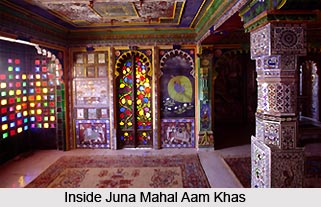 Monuments of Dungarpur are famous for their unique style of architecture as seen in the various palaces and noble residences found here. Nestled in the foothills of the Aravalli Range of mountains, Dungarpur has a beautiful landscape. The monuments of Dungarpur are a story of majesty and finesse ranking high among all the monuments of Rajasthan. Dungarpur was founded in 1282 AD by Rawal Veer Singh when he took captured this part of the state from the Bhil chieftain Dungaria. The ruling dynasty of Dungarpur claim descent from the house of Mewar, the premier Rajput clan, and in spite of the vicissitudes of fortune, they managed to hold a small territory of rough country until afforded protection by the British East India Company in 1818.
Monuments of Dungarpur are famous for their unique style of architecture as seen in the various palaces and noble residences found here. Nestled in the foothills of the Aravalli Range of mountains, Dungarpur has a beautiful landscape. The monuments of Dungarpur are a story of majesty and finesse ranking high among all the monuments of Rajasthan. Dungarpur was founded in 1282 AD by Rawal Veer Singh when he took captured this part of the state from the Bhil chieftain Dungaria. The ruling dynasty of Dungarpur claim descent from the house of Mewar, the premier Rajput clan, and in spite of the vicissitudes of fortune, they managed to hold a small territory of rough country until afforded protection by the British East India Company in 1818.
Dungarpur lies at the base of a hill 700 feet high, on the edge of a cool, refreshing lake. Two rivers, the Som River and the Mahi River run through it. The palaces and royal residences found here are adorned with jharokhas, built in stone in a unique style typical of the area which was developed during the reign of Maharawal Shiv Singh.
Among the prime attractions here are the palaces found. The Juna Palace was built with the intent of defence sometime in the 1500s. The palace resembles a fortress complete with turrets, narrow entrances and crenulated walls. It is an ancient, rambling mass of cream stucco, a chaotic jumble of terraces, pavilions and over sailing balconies, rising up the hill. Its form is dictated by its defensive functions, with narrow internal passages and corridors only wide enough for a single person. The principal rooms are ornamented lavishly with Rajput miniatures, mirror and lacquer work, beautiful frescoes and polished coloured chunam decorated by craftsmen from Udaipur. Though deserted for over 200 years, the interior is remarkably well preserved.
 The Udai Vilas Palace was designed in the late 18th century by Adit Ram Silawat but not completed until the late 19th century, which accounts for the European references in some of the details. It stands beside the lake and is approached by a long drive through the jungle. It is faced in local grey-green stone in a mixed Rajput-Mughal style. Within the central courtyard, which was once a pool, rises an extraordinary ornate pavilion. It is a riot of cusped arches, massive columns and elaborate balconies carried on sinuous, serpentine brackets. Inside, the walls are inlaid with semiprecious stones similar to the Great Taj at Agra. The whole is crowned by a canopied pavilion in exotic Rajput Style.
The modern wing was built in 1943. In the formal garden adjacent is a stone arch brought from a nearby temple, originally part of an elaborate weighing machine used to balance the Maharaja against his weight in gold. The resulting treasure was distributed to the poor.
The Udai Vilas Palace was designed in the late 18th century by Adit Ram Silawat but not completed until the late 19th century, which accounts for the European references in some of the details. It stands beside the lake and is approached by a long drive through the jungle. It is faced in local grey-green stone in a mixed Rajput-Mughal style. Within the central courtyard, which was once a pool, rises an extraordinary ornate pavilion. It is a riot of cusped arches, massive columns and elaborate balconies carried on sinuous, serpentine brackets. Inside, the walls are inlaid with semiprecious stones similar to the Great Taj at Agra. The whole is crowned by a canopied pavilion in exotic Rajput Style.
The modern wing was built in 1943. In the formal garden adjacent is a stone arch brought from a nearby temple, originally part of an elaborate weighing machine used to balance the Maharaja against his weight in gold. The resulting treasure was distributed to the poor.
The Shrine of Shrinathji, located on the embankment of the Gaib Sagar Lake, is the most famous shrine at Dungarpur. It is actually a conglomeration of several small and medium sized temples with one main temple. The most remarkably constructed temple here is the Vijay Raj Rajeshwar temple, dedicated to Lord Shiva. It has been constructed by the Shilpis of Dungarpur and is a testament of the architectural prowess of the region.
The Government Archaeological museum at Dungarpur houses a fine collection of old statues. Monuments of Dungarpur are well known for their architectural splendour and fascinating construction.



















